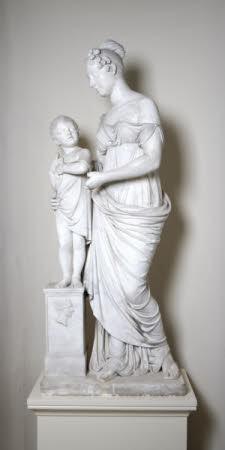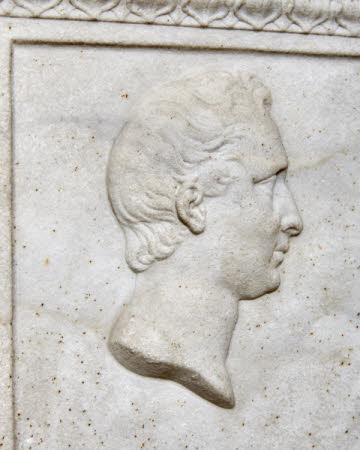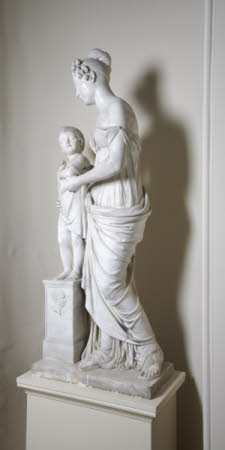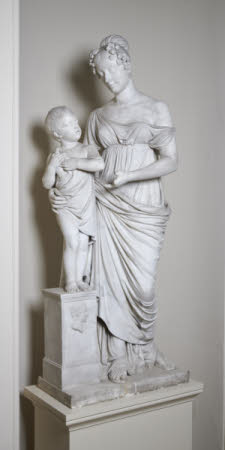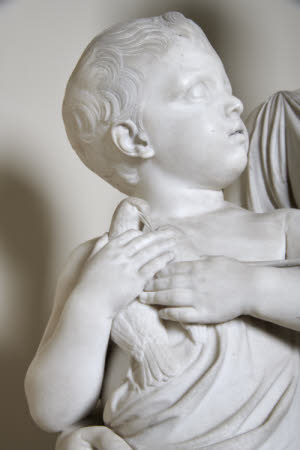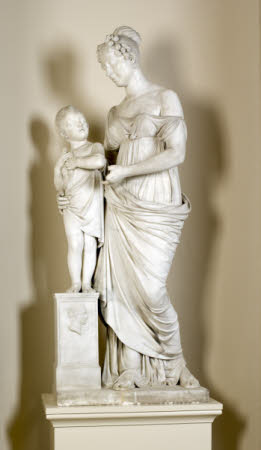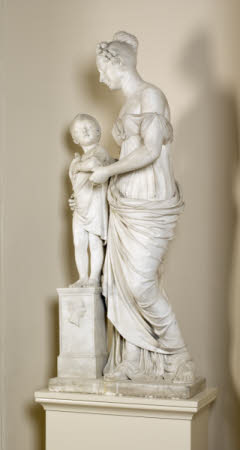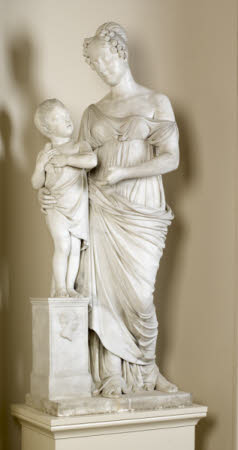Frances Anne, Marchioness of Londonderry with her son, George Henry William Vane-Tempest, Viscount Seaham
Lorenzo Bartolini (Vernio, Tuscany 1777 – Florence 1850)
Category
Art / Sculpture
Date
1823
Materials
Marble
Measurements
1524 mm (60 in) high
Place of origin
Florence
Order this imageCollection
Mount Stewart, County Down
NT 1542334
Caption
Lorenzo Bartolini, the son of a Tuscan blacksmith, a drummer in Napoleon’s army and accomplished musician, became a pupil of Jacques-Louis David and a friend of Ingres on his arrival in Paris. He was later the Director of the Academy at Carrara but a mob destroyed all his work there in 1813. After his revolutionary years he settled in Florence making portrait busts for aristocratic patrons from all over Europe and ideal figures and monuments in the neo-classical style. The statue of Lady Londonderry and her son was modelled in 1823 just after her husband had succeeded to the title after the suicide of his half-brother. The Duke of Devonshire visited the sculptor’s studio on 21st February 1823 and saw the marble statue of ‘Lady Stewart’ but in his diary wrote he found it ‘ridiculous enough’. It echoes a sentimental madonna-and-child type whilst her son is holding a dove. The 3rd Marquess of Londonderry, had already commissioned a Reclining Venus after Titian’s famous painting in the Uffizi, executed around 1822 and a traditional emperor Roman-style portrait bust of himself which was at their family seat in Wynward Park. Co. Durham. The plaster cast of this marble portrait group, which survived from Bartolini’s studio, is now in the Academia in Florence.
Summary
Sculpture, marble; Frances Anne (née Vane-Tempest), Marchioness of Londonderry (1800-1865) and her Son, George Henry William Vane-Tempest, Viscount Seaham (1821-1884); Lorenzo Bartolini (1777-1850); 1823. A marble statue of Lady Londonderry and her young son, born in 1821, the future 5th Marquess of Londonderry. Commissioned from the leading neo-classical sculptor early in 1823, when the Londonderrys spent several weeks in Florence.
Full description
A full-length sculpture by Lorenzo Bartolini (1777-1850), with standing figures of Frances Anne (née Vane-Tempest), Marchioness of Londonderry (1800-1865) and her Son, George William Vane-Tempest, Viscount Seaham (1821-1884). Lady Londonderry is depicted in a diaphanous dress in neo-classical style, with a belt above the waist, the dress slipping off at her left shoulder. Her hair is tightly drawn back into a bun at the back of the head and arranged into curls at the front, and she wears sandals in classical style. Her son stands upon an altar-like pedestal, adorned on the front face with a profile portrait of the 3rd Marquess of Londonderry, Charles William Vane, (1778–1854). George William Vane-Tempest is dressed in a loose shift; he looks up towards his mother, whose hand holds him protectively, and he clutches a bird to his chest. The sculpture is signed on the back of the pedestal. It is damaged, with general wear to the surfaces after its exposure outside for some fifty years following the sale of Londonderry House in 1962. Lady Londonderry’s left arm has been broken just below the elbow, and all the fingers of her left hand are broken. Although his reputation has declined, Lorenzo Bartolini was regarded in his lifetime as one of the very greatest European sculptors, working in the neo-classical tradition that was popular in the first decades of the nineteenth century. Born near Prato into a poor family, he grew up and undertook early training as a sculptor in Florence, moving in 1795 to Volterra, where he worked for the French sculptor in alabaster, Barthélemy Corneille (c. 1760–1812). Whilst working for Corneille, Bartolini came across drawings by Flaxman, which made an enormous impact on him. A supporter of the revolutionary movements sweeping through Europe at this time, Bartolini served briefly in the French army before moving to Paris, where he worked in the studio of the painter Jacques-Louis David and also met and became close friends with the painter Jean-Auguste-Dominique Ingres (1780-1867). Bartolini became one of the favoured artists of the Emperor Napoleon I and his entourage, in 1814 even following the defeated emperor into exile on the island of Elba . After Napoleon’s final defeat, Bartolini established his studio in Florence, but his reputation as a Bonapartist meant that he was for a long time denied access to larger public commissions, so instead made his living largely through sculpted portraits. He soon became the most fashionable portrait sculptor in Florence, sculpting portraits of many of the foreign visitors, a good number of them British and Irish, who flocked to Florence after peace had finally returned to Europe. Bartolini himself estimated that he had between 1816 and 1846 made and dispatched to his clients 500 portrait busts (Tinti 1936, II, p. 11), but the number is thought to have been even greater. The remaining contents of his studio, now in the Galleria dell’Accademia in Florence, include around 300 models for these portrait busts, as well as most of the models for his funerary and ideal sculptures. Bartolini had always been closely interested in Italian art of the earlier periods and, as his career developed, his style evolved towards a more neo-Renaissance manner. The statue of Lady Londonderry and her son was one of two major works commissioned by the third Marquess of Londonderry from Bartolini, the other a life-size Venus of Titian, based on Titian’s famous painting of the Venus of Urbino. That marble was sold early from the collection by the Third Marquess and may be the version today in a collection in the Bahamas, although there are others in the Lady Lever Art Gallery, Port Sunlight and in the Musée Fabre, Montpellier (Bartolini 2011, pp. 263-65, no. 37). The third Marquess also commissioned from Bartolini a portrait bust of himself, formerly at Wynyard Hall, a reduced version of which in alabaster is at Mount Stewart (NT 1220129). In the Galleria dell’Accademia in Florence is a plaster bust of a woman identified as Lady Londonderry (Inv. Sculture 1552). An impressive marble basin at Mount Stewart (NT 1221035) may also be a product of Lorenzo Bartolini’s workshop. The Londonderrys came to Florence early in 1823 from Verona, where the third Marquess had taken part in the Congress of Verona, an international meeting succeeding the Congress of Vienna and, like it, aiming to produce a new European political settlement following the final defeat of Napoleon. They spent six weeks in Florence, before travelling to Rome in mid-February, and Lady Londonderry and her son first sat to Bartolini during this stay (Bartolini 1978, p. 40). When they again passed through Florence in late March 1823 on their return to Britain, Lady Londonderry seems to have returned to Bartolini’s studio (Londonderry 1958, p. 120). The sculpture of Lady Londonderry was being worked on in Bartolini’s studio when it was visited by William Cavendish, Sixth Duke of Devonshire, on 21 February 1823, who described it in his diary as ‘somewhat ridiculous’ (Falletti, Bietoletti, Caputo 2011, p. 89). This disobliging comment may have been in part caused by perceptions among some contemporaries of the Londonderrys as an ostentatious and somewhat vulgar couple. The concept of the sculpture, with its depiction of Frances Anne standing supporting her small son, who stands on an altar-like pedestal, is based on an earlier work by Bartolini, the statue of Elisa Bonaparte Baciocchi, Grand Duchess of Tuscany and her daughter Princess Elisa Napoleona, made around 1813 (Tinti 1936, pp. 31-32, no. 23, Tav. 8; Bartolini 2011, p. 40, fig. 16; Château de Fontainebleau, on deposit from Château de Versailles). In both sculptures, the pose of the standing mother, with her left leg slightly drawn back, her left hand gesturing and head inclined towards her child, are derived from an ancient Greek figure of Aphrodite or Venus, the goddess of love, that is known through many later copies both in marble and in bronze. Bartolini’s original plaster model for his sculpture of lady Londonderry and her son survives in the Galleria dell’Accademia in Florence (Bartolini 1978, p. 40, no. 9). The main difference between the plaster and the finished marble is the addition to the pedestal of a relief portrait of the third Marquess. Although Bartolini made fast progress with starting the model for the statue of Lady Londonderry and her son, its actual execution in marble may have taken much longer. Lord Londonderry appears to have suffered considerable delays in receiving this statue and his Venus after Titian, as may be deduced from letters in 1827 and 1828 to Lord Burghersh, British Minister in Florence (Durham Record Office, correspondence with Lord Burghersh, D/Lo/C 799). On 25 February 1827 Londonderry wrote that ‘I have ordered Coutts to pay Mr. Bartolini's bill and I have urgently to request you will stir him up and force him to embark the statues with as little delay as possible.’. He clearly heard nothing, writing again on 12 July ‘I write these few lines to entreat of you to do something for me with that deuced fellow Bartolini. He promised my statues in March positively, and here in July I hear nothing of him.’, and again on 20 October, ‘Now do row that beast Bartolini and say if I am ever to expect my statues or not.’ Londonderry mentioned Bartolini again in January and then, on 29 April 1828, ‘it will be very kind of you if you will refresh Bartolini's memory again about our statues, which I fairly think now he will never send to us and I can not finish the arrangement of my gallery without them.’ The gallery was that in Holdernesse House (later renamed Londonderry House), which had been extensively rebuilt by Benjamin and Philip Wyatt, with works beginning in 1822 and being completed in the summer of 1828. It may be that because of Bartolini’s tardiness in delivering the sculptures, they could indeed in the end not be incorporated into the main gallery, which may explain why Lord Londonderry sold the copy of the Venus of Urbino just a few years later. Bartolini’s sculpture of Frances Anne and her son, on the other hand, was displayed in Holdernesse/Londonderry House within an arched niche in the entrance hall, so would have been seen by every visitor to the house (Montgomery Hyde 1937, Plate II). However, as it stood against a wall which concealed the signature, the authorship of the sculpture was lost in the course of the many years it was displayed in Londonderry House. It was not sold at auction in 1962 following the sale of Londonderry House and the dispersal of its contents, but was unfortunately then kept in the open air for several decades, firstly in a garden in London and then at Wynyard Hall, near Durham. This exposure to the elements caused significant wearing to the surfaces and other damage, especially to Lady Londonderry’s left arm and hand. Jeremy Warren July 2022
Provenance
On loan from the Estate of the Marquess of Londonderry
Credit line
Estate of the Marquess of Londonderry
Marks and inscriptions
On back of pedestal:: BARTOLINI. FACEVA
Makers and roles
Lorenzo Bartolini (Vernio, Tuscany 1777 – Florence 1850), sculptor
References
Tinti 1936 Mario Tinti, Lorenzo Bartolini, 1936, II, p. 12, p. 47, no. XLIX, Tav. XXXII. Londonderry 1958: Edith, Marchioness of Londonderry, Frances Anne. The Life and Times of Frances Anne, Marchioness of Londonderry and her husband Charles, Third Marquess of Londonderry, London 1958, p. 120. Bartolini 1978: Lorenzo Bartolini. Mostra delle attività di tutela, exh. cat. Palazzo Pretorio, Prato, Florence 1978, pp. 40-41, no. 9. Kenworthy-Browne 1978: John Kenworthy-Browne, 'Sculptor and revolutionary. British portraits by Bartolini', Country Life. 8 June 1978, pp.1655-56, fig. 6 Lorenzo Bartolini Beauty and Truth in Marble (Franca Falletti, Silvestra Bietoletti, Annarita Caputo), Galleria dell'Accademia 31st May - 6th November 2011, illustrated opp.p. 87 as Anne Vane-Tempest, Marchioness of Londonderry with her son George Bartolini 2011: Franca Falletti, Silvestra Bietoletti and Annarita Caputo, eds., Lorenzo Bartolini. Scultore del bello naturale, exh.cat. Galleria dell’Accademia, Florence 2011, pp. 86, 94. Kenworthy-Browne 2014: John Kenworthy-Browne, ‘Rediscovering Bartolini’s busts and statues in Britain’ in Silvestra Bietoletti, Annarita Caputo and Franca Falletti, eds., Lorenzo Bartolini. Atti delle Giornate di Studio, Pistoia 2014, pp. 48-60, p. 57.
